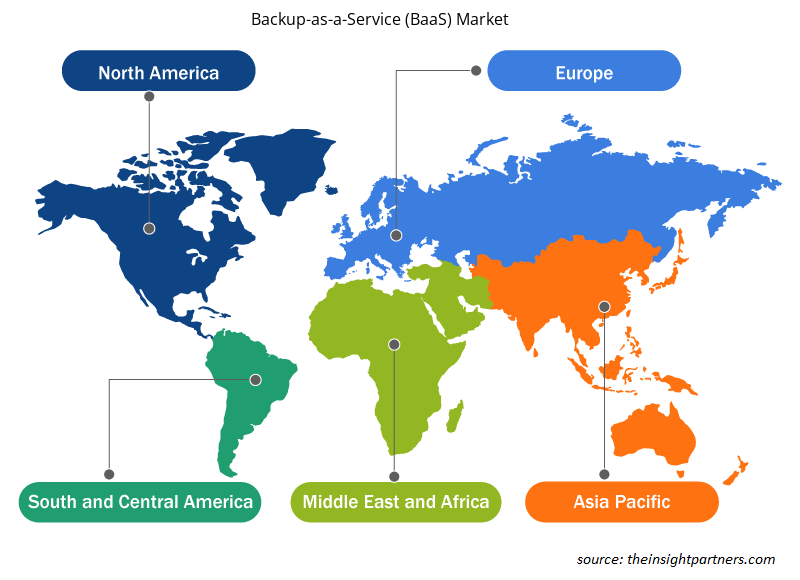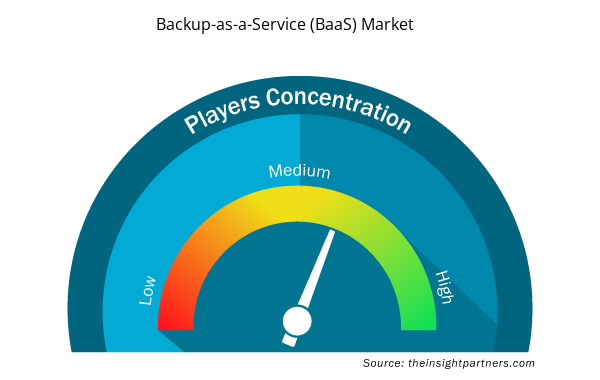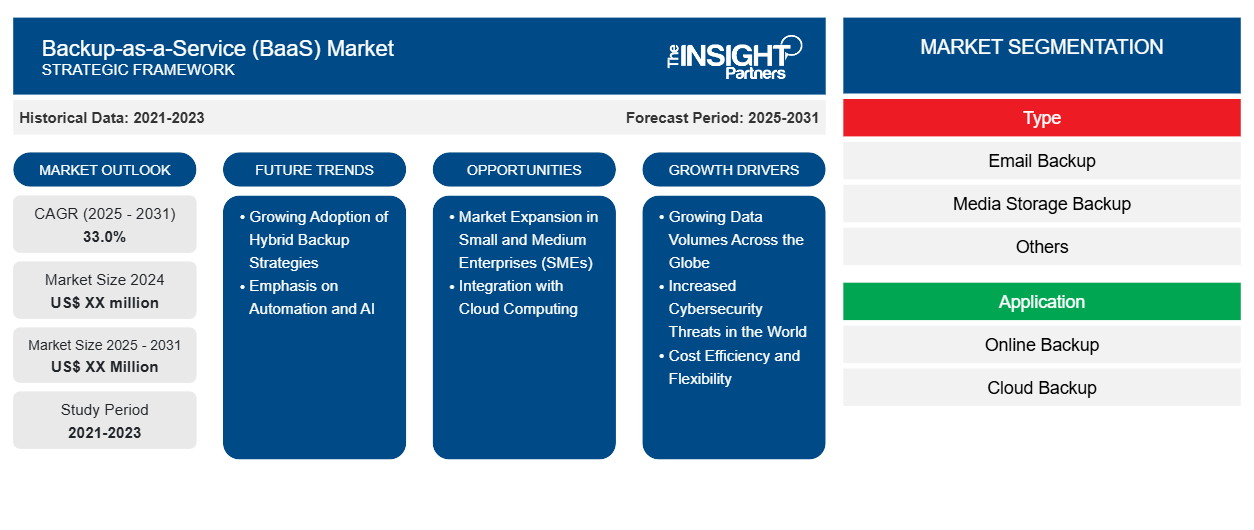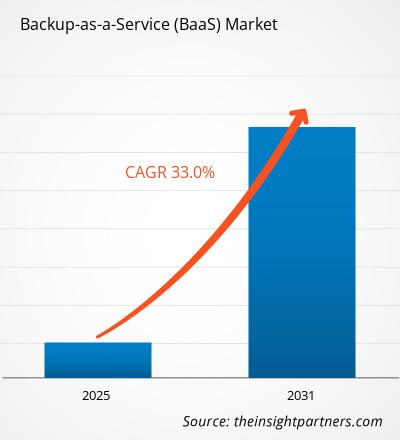Si prevede che il mercato Backup-as-a-Service (BaaS) registrerà un CAGR del 33,0% dal 2023 al 2031, con una dimensione di mercato in espansione da XX milioni di dollari nel 2023 a XX milioni di dollari entro il 2031.
Il report è segmentato per Tipo (Backup e-mail, Backup di archiviazione multimediale, Altri); Applicazione (Backup online, Backup su cloud); Settore di utilizzo finale (BFSI, Governo e settori pubblici, Sanità, Produzione, Media e intrattenimento, Telecomunicazioni e IT, Altri). L'analisi globale è ulteriormente suddivisa a livello regionale e nei principali paesi. Il report offre il valore in USD per l'analisi e i segmenti di cui sopra
Scopo del rapporto
Il report Backup-as-a-Service (BaaS) Market di The Insight Partners mira a descrivere il panorama attuale e la crescita futura, i principali fattori trainanti, le sfide e le opportunità. Ciò fornirà spunti a vari stakeholder aziendali, come:
- Fornitori/produttori di tecnologia: per comprendere le dinamiche di mercato in evoluzione e conoscere le potenziali opportunità di crescita, consentendo loro di prendere decisioni strategiche informate.
- Investitori: condurre un'analisi completa delle tendenze in merito al tasso di crescita del mercato, alle proiezioni finanziarie del mercato e alle opportunità esistenti lungo la catena del valore.
- Enti di regolamentazione: regolamentano le politiche e le attività di controllo sul mercato allo scopo di ridurre al minimo gli abusi, preservare la fiducia degli investitori e sostenere l'integrità e la stabilità del mercato.
Segmentazione del mercato del backup come servizio (BaaS)
Tipo
- Backup della posta elettronica
- Backup dell'archiviazione multimediale
- Altri
Applicazione
- Backup online
- Backup nel cloud
Settore di utilizzo finale
- BFSI
- Governo e settore pubblico
- Assistenza sanitaria
- Produzione
- Media e intrattenimento
- Telecomunicazioni e IT
- Altri
Geografia
- America del Nord
- Europa
- Asia-Pacifico
- America del Sud e Centro
- Medio Oriente e Africa
Geografia
- America del Nord
- Europa
- Asia-Pacifico
- America del Sud e Centro
- Medio Oriente e Africa
Personalizza questo report in base alle tue esigenze
Riceverai la personalizzazione gratuita di qualsiasi report, comprese parti di questo report, o analisi a livello nazionale, pacchetto dati Excel, oltre a usufruire di grandi offerte e sconti per start-up e università
- Scopri le principali tendenze di mercato in questo rapporto.Questo campione GRATUITO includerà analisi di dati che spaziano dalle tendenze di mercato alle stime e alle previsioni.
Driver di crescita del mercato del backup come servizio (BaaS)
- Volumi di dati in crescita in tutto il mondo: la crescita esponenziale dei dati generati dalle aziende in vari settori è un motore primario del mercato Backup-as-a-Service (BaaS). Poiché le organizzazioni accumulano grandi quantità di dati da operazioni, transazioni e interazioni con i clienti, la necessità di soluzioni di backup efficaci e scalabili si è intensificata. BaaS offre alle aziende un modo affidabile per archiviare, proteggere e recuperare i propri dati critici senza la complessità di gestire infrastrutture di backup in sede. Questa richiesta di soluzioni di gestione dei dati efficienti incoraggia le aziende ad adottare BaaS come mezzo per salvaguardare le proprie informazioni dalla perdita di dati, garantendo la continuità aziendale e la conformità agli standard normativi.
- Aumento delle minacce alla sicurezza informatica nel mondo: la crescente frequenza e sofisticatezza degli attacchi informatici, come ransomware e violazioni dei dati, sono fattori trainanti significativi del mercato BaaS. Le organizzazioni sono sempre più consapevoli delle vulnerabilità nei loro sistemi di sicurezza dei dati e dei potenziali danni finanziari e reputazionali che possono derivare dalla perdita di dati. Le soluzioni BaaS forniscono una solida protezione contro tali minacce offrendo backup automatizzati, crittografia e opzioni di ripristino rapido. Mentre le aziende cercano di migliorare la propria postura di sicurezza informatica e ridurre al minimo i rischi associati alla perdita di dati, l'adozione di BaaS continua a crescere, rendendolo una componente essenziale delle moderne strategie di protezione dei dati.
- Efficienza dei costi e flessibilità: le aziende sono costantemente alla ricerca di modi per ottimizzare i costi mantenendo pratiche di gestione dei dati efficaci. BaaS fornisce un'alternativa conveniente alle tradizionali soluzioni di backup eliminando la necessità di significativi investimenti iniziali in hardware e software. Con BaaS, le organizzazioni possono pagare solo per lo storage che utilizzano, consentendo una maggiore flessibilità nel budget e nell'allocazione delle risorse. Inoltre, la scalabilità delle soluzioni BaaS consente alle aziende di adattare la propria capacità di backup man mano che le esigenze dei dati evolvono, rendendola un'opzione interessante per le aziende che cercano di semplificare le operazioni e ridurre le spese generali IT.
Tendenze future del mercato del Backup-as-a-Service (BaaS)
- Crescente adozione di strategie di backup ibride: una tendenza significativa nel mercato BaaS è la crescente preferenza per strategie di backup ibride, che combinano soluzioni on-premise e basate su cloud. Le organizzazioni stanno riconoscendo i vantaggi di avere backup sia locali che off-site per garantire ridondanza dei dati e capacità di ripristino rapido. Questo approccio consente alle aziende di bilanciare prestazioni e sicurezza, adattandosi al contempo a diversi requisiti di conformità. Man mano che le organizzazioni cercano di ottimizzare le proprie strategie di backup, si prevede che la domanda di soluzioni BaaS ibride flessibili aumenterà, influenzando le offerte di servizi sul mercato.
- Enfasi su automazione e intelligenza artificiale: un'altra tendenza emergente nel mercato BaaS è la crescente enfasi su automazione e intelligenza artificiale (IA) per migliorare i processi di backup. L'automazione semplifica le pianificazioni di backup, riduce gli errori umani e garantisce pratiche di protezione dei dati coerenti. Nel frattempo, le tecnologie di IA possono analizzare i dati di backup per identificare anomalie o potenziali guasti, consentendo misure proattive per mitigare i rischi. Poiché le organizzazioni danno priorità all'efficienza e all'affidabilità nelle loro strategie di gestione dei dati, l'integrazione di automazione e IA nelle soluzioni BaaS continuerà a plasmare gli sviluppi del mercato, portando a offerte di servizi migliorate e a una migliore soddisfazione del cliente.
Opportunità di mercato del Backup-as-a-Service (BaaS)
- Espansione del mercato nelle piccole e medie imprese (PMI): il mercato BaaS offre notevoli opportunità di crescita all'interno delle piccole e medie imprese (PMI). Molte PMI affrontano sfide nell'implementazione di soluzioni di backup efficaci a causa di risorse e competenze limitate. I provider BaaS possono personalizzare i propri servizi per soddisfare le esigenze specifiche di queste aziende, offrendo opzioni di backup convenienti e facili da gestire. Man mano che la consapevolezza della protezione dei dati cresce tra le PMI, è probabile che la domanda di BaaS aumenti, presentando un segmento di mercato redditizio per i provider di servizi che cercano di espandere la propria portata e acquisire nuovi clienti.
- Integrazione con il cloud computing: il continuo passaggio al cloud computing presenta ampie opportunità per il mercato BaaS. Poiché le organizzazioni migrano sempre più le loro operazioni sul cloud, l'integrazione di soluzioni di backup con infrastrutture cloud esistenti può migliorare i processi di protezione e ripristino dei dati. I provider BaaS possono sfruttare le partnership con i provider di servizi cloud per offrire soluzioni senza soluzione di continuità che si allineano alle strategie cloud dei clienti. Questa integrazione non solo migliora l'efficienza operativa, ma presenta anche opportunità di cross-selling e upselling di servizi aggiuntivi, guidando così la crescita dei ricavi per i provider BaaS.
Approfondimenti regionali sul mercato del Backup-as-a-Service (BaaS)
Le tendenze regionali e i fattori che influenzano il mercato Backup-as-a-Service (BaaS) durante il periodo di previsione sono stati ampiamente spiegati dagli analisti di Insight Partners. Questa sezione discute anche i segmenti di mercato Backup-as-a-Service (BaaS) e la geografia in Nord America, Europa, Asia Pacifico, Medio Oriente e Africa e Sud e Centro America.

- Ottieni i dati specifici regionali per il mercato Backup-as-a-Service (BaaS)
Ambito del rapporto di mercato Backup-as-a-Service (BaaS)
| Attributo del report | Dettagli |
|---|---|
| Dimensioni del mercato nel 2023 | XX milioni di dollari USA |
| Dimensioni del mercato entro il 2031 | XX milioni di dollari USA |
| CAGR globale (2023-2031) | 33,0% |
| Dati storici | 2021-2022 |
| Periodo di previsione | 2024-2031 |
| Segmenti coperti | Per tipo
|
| Regioni e Paesi coperti | America del Nord
|
| Leader di mercato e profili aziendali chiave |
|
Densità degli attori del mercato Backup-as-a-Service (BaaS): comprendere il suo impatto sulle dinamiche aziendali
Il mercato Backup-as-a-Service (BaaS) sta crescendo rapidamente, spinto dalla crescente domanda degli utenti finali dovuta a fattori quali l'evoluzione delle preferenze dei consumatori, i progressi tecnologici e una maggiore consapevolezza dei vantaggi del prodotto. Con l'aumento della domanda, le aziende stanno ampliando le loro offerte, innovando per soddisfare le esigenze dei consumatori e capitalizzando sulle tendenze emergenti, il che alimenta ulteriormente la crescita del mercato.
La densità degli operatori di mercato si riferisce alla distribuzione di aziende o società che operano in un particolare mercato o settore. Indica quanti concorrenti (operatori di mercato) sono presenti in un dato spazio di mercato in relazione alle sue dimensioni o al valore di mercato totale.
Le principali aziende che operano nel mercato Backup-as-a-Service (BaaS) sono:
- Servizi Web Amazon, Inc.
- Broadcom
- Cisco Systems, Inc.
- Dell Inc.
- FUJITSU
Disclaimer : le aziende elencate sopra non sono classificate secondo un ordine particolare.

- Ottieni una panoramica dei principali attori del mercato Backup-as-a-Service (BaaS)
Punti di forza chiave
- Copertura completa: il rapporto copre in modo completo l'analisi di prodotti, servizi, tipologie e utenti finali del mercato Backup-as-a-Service (BaaS), fornendo una panoramica olistica.
- Analisi degli esperti: il rapporto è compilato sulla base della conoscenza approfondita di esperti e analisti del settore.
- Informazioni aggiornate: il rapporto garantisce la pertinenza aziendale grazie alla copertura di informazioni recenti e tendenze nei dati.
- Opzioni di personalizzazione: questo report può essere personalizzato per soddisfare le esigenze specifiche del cliente e adattarsi in modo appropriato alle strategie aziendali.
Il rapporto di ricerca sul Backup-as-a-Service (BaaS) Market può, quindi, aiutare a guidare il percorso di decodifica e comprensione dello scenario del settore e delle prospettive di crescita. Sebbene possano esserci alcune preoccupazioni valide, i vantaggi complessivi di questo rapporto tendono a superare gli svantaggi.
- Analisi storica (2 anni), anno base, previsione (7 anni) con CAGR
- Analisi PEST e SWOT
- Valore/volume delle dimensioni del mercato - Globale, regionale, nazionale
- Industria e panorama competitivo
- Set di dati Excel


- Photo Editing Software Market
- Non-Emergency Medical Transportation Market
- Vessel Monitoring System Market
- Authentication and Brand Protection Market
- Terahertz Technology Market
- MEMS Foundry Market
- Nitrogenous Fertilizer Market
- Extracellular Matrix Market
- Wire Harness Market
- Oxy-fuel Combustion Technology Market

Report Coverage
Revenue forecast, Company Analysis, Industry landscape, Growth factors, and Trends

Segment Covered
This text is related
to segments covered.

Regional Scope
North America, Europe, Asia Pacific, Middle East & Africa, South & Central America

Country Scope
This text is related
to country scope.
Domande frequenti
Some of the customization options available based on the request are an additional 3-5 company profiles and country-specific analysis of 3-5 countries of your choice. Customizations are to be requested/discussed before making final order confirmation# as our team would review the same and check the feasibility
The report can be delivered in PDF/PPT format; we can also share excel dataset based on the request
Adoption of cloud-based solutions to play a significant role in the global backup-as-a-service (BaaS) market in the coming years
Explosive growth in data and rising cyber threats and regulatory compliance requirements are the major factors driving the backup-as-a-service (BaaS) market
The Backup-as-a-Service (BaaS) Market is estimated to witness a CAGR of 33.0% from 2023 to 2031
Trends and growth analysis reports related to Technology, Media and Telecommunications : READ MORE..
1. Amazon Web Services, Inc.
2. Broadcom
3. Cisco Systems, Inc.
4. Dell Inc.
5. FUJITSU
6. Google LLC
7.IBM Corporation
8. Microsoft
9. NetApp Inc.
10. Oracle
The Insight Partners performs research in 4 major stages: Data Collection & Secondary Research, Primary Research, Data Analysis and Data Triangulation & Final Review.
- Data Collection and Secondary Research:
As a market research and consulting firm operating from a decade, we have published and advised several client across the globe. First step for any study will start with an assessment of currently available data and insights from existing reports. Further, historical and current market information is collected from Investor Presentations, Annual Reports, SEC Filings, etc., and other information related to company’s performance and market positioning are gathered from Paid Databases (Factiva, Hoovers, and Reuters) and various other publications available in public domain.
Several associations trade associates, technical forums, institutes, societies and organization are accessed to gain technical as well as market related insights through their publications such as research papers, blogs and press releases related to the studies are referred to get cues about the market. Further, white papers, journals, magazines, and other news articles published in last 3 years are scrutinized and analyzed to understand the current market trends.
- Primary Research:
The primarily interview analysis comprise of data obtained from industry participants interview and answers to survey questions gathered by in-house primary team.
For primary research, interviews are conducted with industry experts/CEOs/Marketing Managers/VPs/Subject Matter Experts from both demand and supply side to get a 360-degree view of the market. The primary team conducts several interviews based on the complexity of the markets to understand the various market trends and dynamics which makes research more credible and precise.
A typical research interview fulfils the following functions:
- Provides first-hand information on the market size, market trends, growth trends, competitive landscape, and outlook
- Validates and strengthens in-house secondary research findings
- Develops the analysis team’s expertise and market understanding
Primary research involves email interactions and telephone interviews for each market, category, segment, and sub-segment across geographies. The participants who typically take part in such a process include, but are not limited to:
- Industry participants: VPs, business development managers, market intelligence managers and national sales managers
- Outside experts: Valuation experts, research analysts and key opinion leaders specializing in the electronics and semiconductor industry.
Below is the breakup of our primary respondents by company, designation, and region:

Once we receive the confirmation from primary research sources or primary respondents, we finalize the base year market estimation and forecast the data as per the macroeconomic and microeconomic factors assessed during data collection.
- Data Analysis:
Once data is validated through both secondary as well as primary respondents, we finalize the market estimations by hypothesis formulation and factor analysis at regional and country level.
- Macro-Economic Factor Analysis:
We analyse macroeconomic indicators such the gross domestic product (GDP), increase in the demand for goods and services across industries, technological advancement, regional economic growth, governmental policies, the influence of COVID-19, PEST analysis, and other aspects. This analysis aids in setting benchmarks for various nations/regions and approximating market splits. Additionally, the general trend of the aforementioned components aid in determining the market's development possibilities.
- Country Level Data:
Various factors that are especially aligned to the country are taken into account to determine the market size for a certain area and country, including the presence of vendors, such as headquarters and offices, the country's GDP, demand patterns, and industry growth. To comprehend the market dynamics for the nation, a number of growth variables, inhibitors, application areas, and current market trends are researched. The aforementioned elements aid in determining the country's overall market's growth potential.
- Company Profile:
The “Table of Contents” is formulated by listing and analyzing more than 25 - 30 companies operating in the market ecosystem across geographies. However, we profile only 10 companies as a standard practice in our syndicate reports. These 10 companies comprise leading, emerging, and regional players. Nonetheless, our analysis is not restricted to the 10 listed companies, we also analyze other companies present in the market to develop a holistic view and understand the prevailing trends. The “Company Profiles” section in the report covers key facts, business description, products & services, financial information, SWOT analysis, and key developments. The financial information presented is extracted from the annual reports and official documents of the publicly listed companies. Upon collecting the information for the sections of respective companies, we verify them via various primary sources and then compile the data in respective company profiles. The company level information helps us in deriving the base number as well as in forecasting the market size.
- Developing Base Number:
Aggregation of sales statistics (2020-2022) and macro-economic factor, and other secondary and primary research insights are utilized to arrive at base number and related market shares for 2022. The data gaps are identified in this step and relevant market data is analyzed, collected from paid primary interviews or databases. On finalizing the base year market size, forecasts are developed on the basis of macro-economic, industry and market growth factors and company level analysis.
- Data Triangulation and Final Review:
The market findings and base year market size calculations are validated from supply as well as demand side. Demand side validations are based on macro-economic factor analysis and benchmarks for respective regions and countries. In case of supply side validations, revenues of major companies are estimated (in case not available) based on industry benchmark, approximate number of employees, product portfolio, and primary interviews revenues are gathered. Further revenue from target product/service segment is assessed to avoid overshooting of market statistics. In case of heavy deviations between supply and demand side values, all thes steps are repeated to achieve synchronization.
We follow an iterative model, wherein we share our research findings with Subject Matter Experts (SME’s) and Key Opinion Leaders (KOLs) until consensus view of the market is not formulated – this model negates any drastic deviation in the opinions of experts. Only validated and universally acceptable research findings are quoted in our reports.
We have important check points that we use to validate our research findings – which we call – data triangulation, where we validate the information, we generate from secondary sources with primary interviews and then we re-validate with our internal data bases and Subject matter experts. This comprehensive model enables us to deliver high quality, reliable data in shortest possible time.


 Ottieni un campione gratuito per questo repot
Ottieni un campione gratuito per questo repot